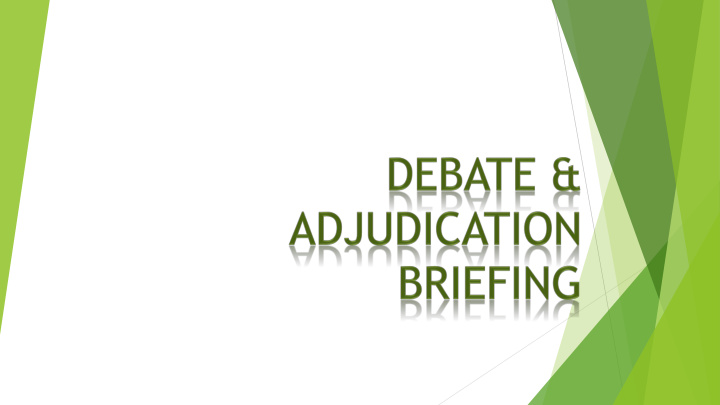



CHAPTER 1 Structure (Asian Parliamentary Debate)
Asian Parliamentary Teams 3 Debaters (per team) 2 Teams (per debate) At least 1 Adjudicator (per room)
Structure: Room Setup
Structure: Room Setup
Structure: Room Setup
Structure: Room Setup
Structure: Speaking Order
Structure: Timing Substantives UNPROTECTED TIME : POIs ALLOWED 1 2 3 4 5 6 7 7.20 PROTECTED TIME: NO POIs ALLOWED Reply Speeches 4.20 1 2 3 4
RULEs to remember Electronic Devices Printed Material No phones Allowed During Prep Time No Computers Not During Speech Only Dictionaries Time Management Help from coach or teacher Debate Preparation 30 mins When preparation begins you are on your own. Adjudicator Decision: 15 mins NO ONE is allowed to help you. Oral Adjudicator: 7 mins each What do you do if you don’t understand the motion? Ask a member of the adjudication core, and we will explain to you *** Timing is strictly controlled*** Penalty: You could get disqualified from the tournament
CHAPTER 2 The debate
The Debate: Motion The Theme Every round has a theme. Debaters are expected to follow the theme when discussing the motion. The debate must have a direct link not only to the motion, but also to the theme of the round Example If the motions is “This house would fight fire with fire” , and the theme is International Relations defining the motion to talk about military action on cross boarder conflicts makes more sense than talking about death penalty for murderers
The Debate: Motion What is a motion? A clearly worded statement that announces the topic to be debated in the round Types Of Motions THBT (This House Believes That) 1. THW (This House Would) 2. TH (This House) 3.
The Debate: Team Roles Proposition Opposition • Support the motion & • Go against the motion give a definition • Realize the problem, but go against PROP’s • Realize the problem proposal and propose a • Provide counter- solution/change model or alternative • Provide model or • Stick with status quo mechanism (the detailed • Engage with Pro. side implementation process) • Engage with Opp side
The Debate: Point of Information (POI) 1. STRICTLY no longer than 20 seconds 2. POIs (point of interests) are Points of clarification 1. Points of Contention 2. 3. Stand up 4. No hackling 5. Chair controls the room
Chapter 3: Judging a debate
Judging: Who is an Adjudicator? Is an average reasonable person At least university degree Has no specific knowledge on issues A fairly logical person, and listens to reason Does not have a personal attachment to the motion Is politically correct (penalizes hate speech or any personal attacks by debaters)
Judging: Who is an adjudicator? Avoid Entering Debates Your specific knowledge about an issue should not influence your decision Your personal biases is not a reason to base your judgment on
Judging: Assessment of clashes Adjudicators listen to material presented in the debate, and the debate alone Ignores personal opinion towards and issue, and judges the debate objectively What do you do when you notice factual errors What about debates against your own moral values?
Judging: Entering a debate In judging don’t use: Specific Knowledge you have about an issue Personal values as a basis for judgment ***Judge debates ONLY based on what is being presented to you***
Judging: Elements of debate Matter Manner Matter Persuasiveness Facts Clarity Logical reasoning Manner Body language Analysis Method Eye contact Case studies Responsiveness Up to date information Method Technicality of debate Timing / Time allocation Role fulfillment Discipline
Judging: Weighing and Prioritizing clashes 1. What is the most important clash in the debate? Who presented it and how well? 1. 2. What are the burdens of proof? 3. Which side responded better to the developments through the debate
Judging: New Matter & Late Development of Matter Constructive Speeches PM, DPM, LO, DLO Substantive speeches Whip Speakers Reply Speeches No new ideas
Judging: Marking Guide & Margin What are the range? Margin Total Meaning Margins Meaning 0.5-3.5 A very close debate with only minor differences 68-70 Poor separating the teams 71-73 Below 4-7 A relatively clear debate Average with one team having an 74 Average or obvious advantage Expected 7.5-16 Trashing. A very clear win Standard with the losing team failing 75-77 Above on one or more fundamental Average aspects of its argument or 78-80 Excellent presentation
Q & A?
Recommend
More recommend